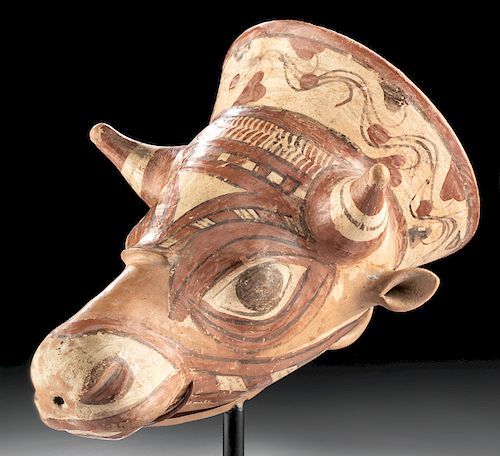Phrygian Polychrome Rhyton - Bull's Head Form
Lot 38
About Seller
Artemis Gallery
686 S Taylor Ave, Ste 106
Louisville, CO 80027
United States
Selling antiquities, ancient and ethnographic art online since 1993, Artemis Gallery specializes in Classical Antiquities (Egyptian, Greek, Roman, Near Eastern), Asian, Pre-Columbian, African / Tribal / Oceanographic art. Our extensive inventory includes pottery, stone, metal, wood, glass and textil...Read more
Estimate:
$24,000 - $36,000
Absentee vs Live bid
Two ways to bid:
- Leave a max absentee bid and the platform will bid on your behalf up to your maximum bid during the live auction.
- Bid live during the auction and your bids will be submitted real-time to the auctioneer.
Bid Increments
| Price | Bid Increment |
|---|---|
| $0 | $25 |
| $300 | $50 |
| $1,000 | $100 |
| $2,000 | $250 |
| $5,000 | $500 |
| $10,000 | $1,000 |
| $20,000 | $2,500 |
| $50,000 | $5,000 |
| $100,000 | $10,000 |
| $200,000 | $20,000 |
About Auction
By Artemis Gallery
Feb 13, 2020
Set Reminder
2020-02-13 10:00:00
2020-02-13 10:00:00
America/New_York
Bidsquare
Bidsquare : Exceptional Antiquities, Asian, Ethnographic
https://www.bidsquare.com/auctions/artemis-gallery/exceptional-antiquities-asian-ethnographic-4848
An important one-day auction featuring museum-worthy examples of Egyptian, Greek, Roman, Etruscan, Near Eastern, Far East / Asian, Pre-Columbian, African / Tribal, Oceanic, Native American, Spanish Colonial, Russian, Fossils, Ancient Jewelry, Fine Art, so much more! Artemis Gallery info@artemisgallery.com
An important one-day auction featuring museum-worthy examples of Egyptian, Greek, Roman, Etruscan, Near Eastern, Far East / Asian, Pre-Columbian, African / Tribal, Oceanic, Native American, Spanish Colonial, Russian, Fossils, Ancient Jewelry, Fine Art, so much more! Artemis Gallery info@artemisgallery.com
- Lot Description
East Greek, Phrygian, ca. 7th to 6th century BCE. A mesmerizing terracotta bull rhyton beautifully finished in a polychrome palette of red, cream, and black. The bovine's visage presents a penetrating gaze with enormous almond-shaped eyes, a prominent snout delineated with recessed nostrils, pointed horns in high relief, and petite ears below. The bull wears a decorative bridle rendered by the artist with registers of diagonal frets and striated passages. Further imbuing the vessel with even more charm, the neck of the rhyton is adorned by a leafy, berried vine. A strap handle joins the neck to the underside of the bull's head for easy handling, and there is a perforation at the mouth for pouring libations. The vessel, while in many respects realistic, simultaneously demonstrates the artist's creative stylized approach. Size: 8.5" L x 6.5" W handle to opposite end (21.6 cm x 16.5 cm); 9.75" H (24.8 cm) on included custom stand.
Rhytons like this example demonstrate the ancients' refined taste for special tableware, and this piece was probably used both as a drinking cup and as a pouring vessel to decant wine into drinking bowls during festive banquets; it may also have been made solely to grace a high status tomb. Zoomorphic forms like this one were popular throughout the Classical world, and bulls symbolized power, signifying virility and masculinity.
A similar Phrygian polychrome bull head rhyton sold for 9,600 GBP ($12,469) at Christie's London - 20 April 2005 - Lot 83.
Provenance: private East Coast, USA collection; ex-Madame Frances Artuner collection, Brussels, Belgium, acquired in the 1960s
All items legal to buy/sell under U.S. Statute covering cultural patrimony Code 2600, CHAPTER 14, and are guaranteed to be as described or your money back.
A Certificate of Authenticity will accompany all winning bids.
We ship worldwide and handle all shipping in-house for your convenience.
#152889Repaired from several large pieces with restoration over the break lines. Expected surface wear with some loss to pigmentation though so much remains vivid. Perforations through neck of figure likely made for suspending or attaching the vessel. Perforation through mouth for pouring libations.Condition
- Shipping Info
-
All shipping is handled in-house for your convenience. Your invoice from Artemis Gallery will include shipping calculation instructions. If in doubt, please inquire BEFORE bidding for estimated shipping costs for individual items.
-
- Buyer's Premium



 EUR
EUR CAD
CAD AUD
AUD GBP
GBP MXN
MXN HKD
HKD CNY
CNY MYR
MYR SEK
SEK SGD
SGD CHF
CHF THB
THB















